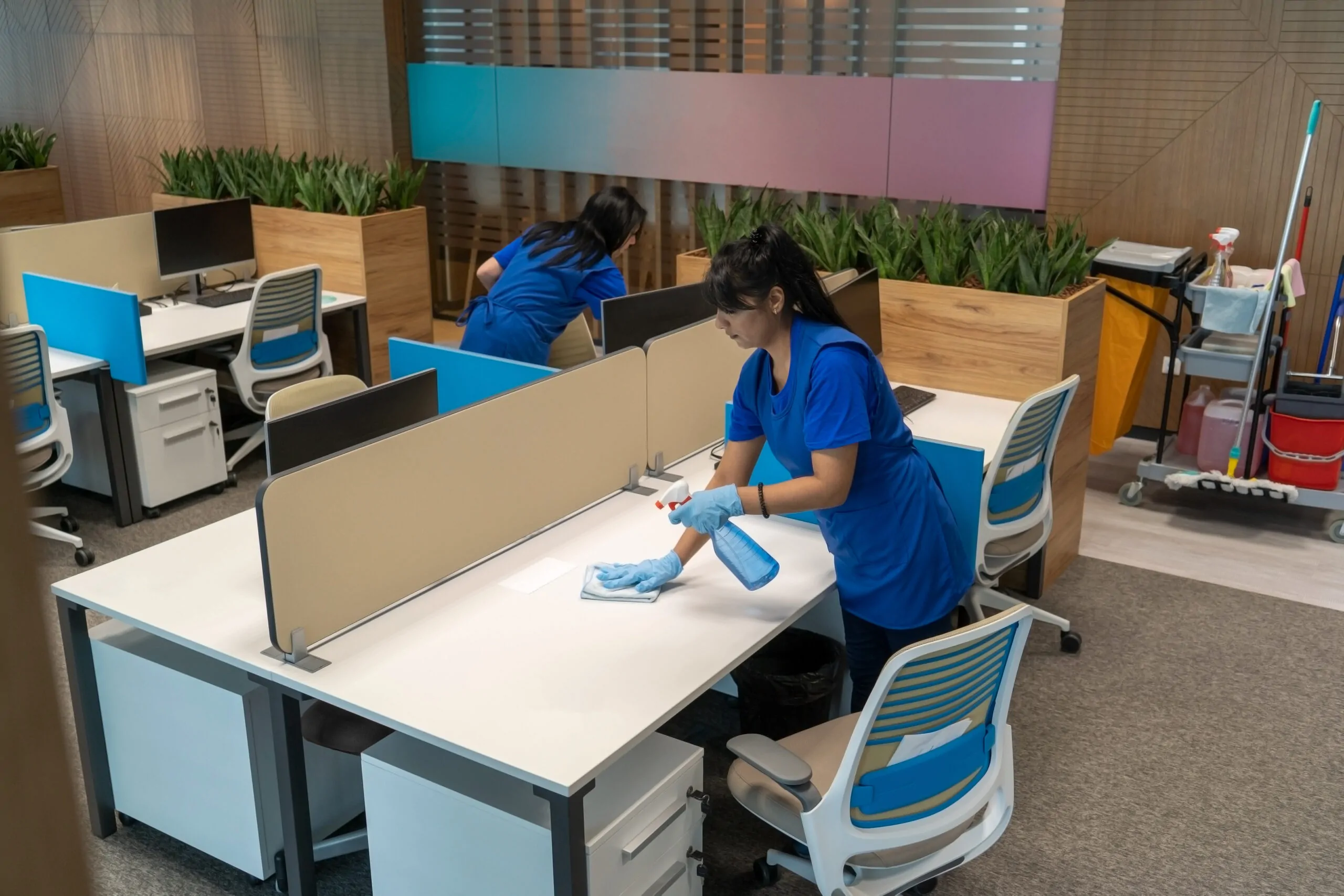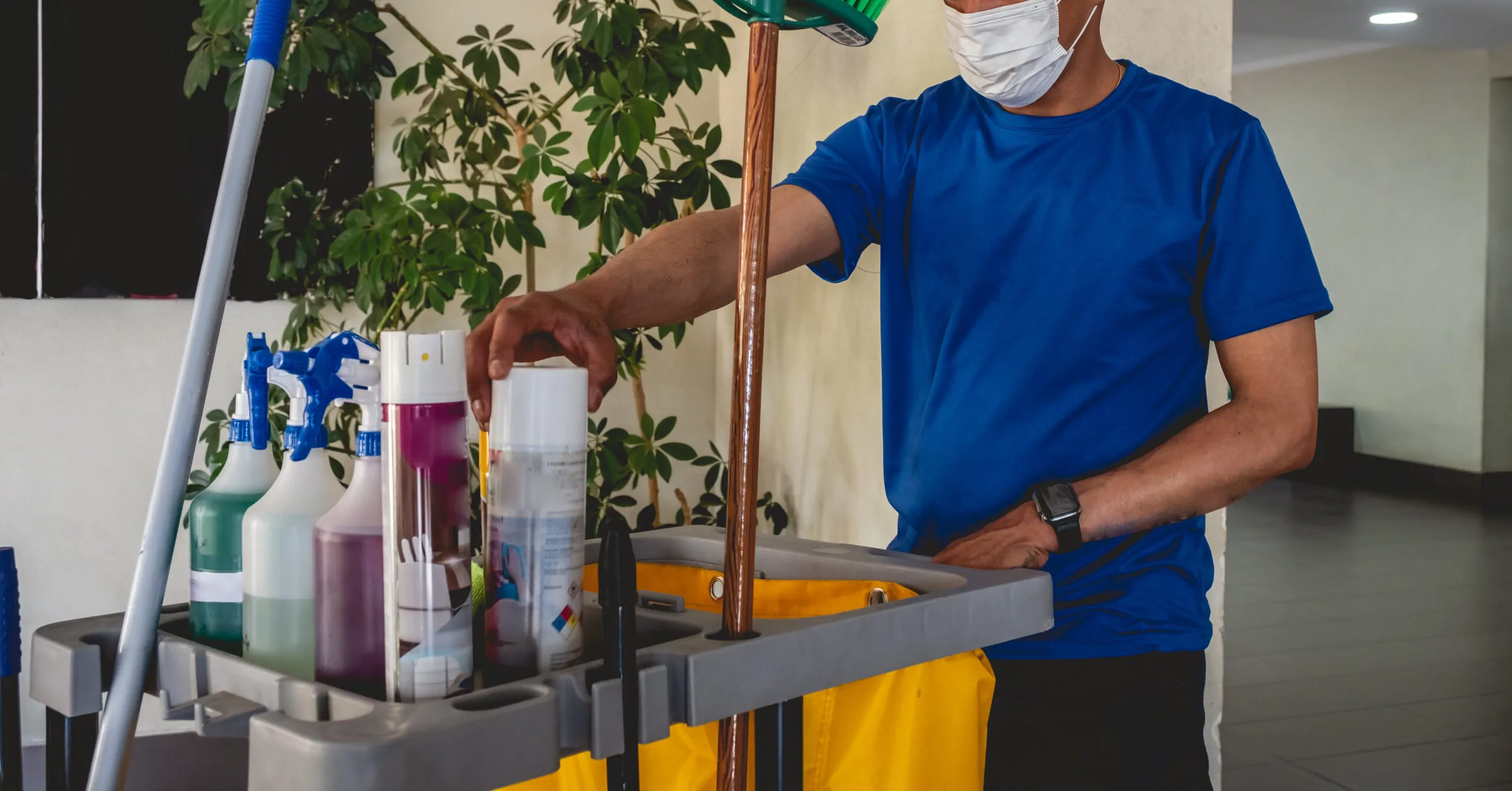What is Janitorial Facilities Maintenance: A Complete Guide
Janitorial facilities maintenance is the systematic upkeep of commercial and industrial buildings through scheduled cleaning and sanitation. It plays a significant role in maintaining health, safety, and productivity in shared spaces. From offices to schools and hospitals to warehouses, janitorial maintenance ensures buildings remain clean, functional, and welcoming.
Moreover, facility cleanliness reflects professionalism, care for safety, and the operational efficiency of workplaces, schools, and other shared spaces. When janitorial services are executed correctly, they not only maintain cleanliness but also extend the life of a building’s infrastructure. In addition, these services contribute to a healthier indoor environment and create a better impression and ambiance for both visitors and staff.
Janitorial maintenance is an essential front-line service supporting workplace wellness and business continuity. Consistent and professional janitorial services are necessary, with higher expectations for sanitation and hygiene, especially post-pandemic. They represent a facility’s commitment and adherence to cleanliness, care, and health standards.
General Nature of Janitorial Facilities Maintenance
Janitorial facilities maintenance refers to the day-to-day and scheduled cleaning services that maintain the hygiene and presentation of a building. These services typically include floor care, surface sanitation, waste disposal, and restroom upkeep. The goal is to provide occupants and visitors with a clean and safe environment.
This type of maintenance involves more than basic cleaning. It consists in following a structured routine, using professional-grade equipment, and adhering to safety and environmental standards. Moreover, killed janitorial teams work according to customized cleaning plans suited to each facility’s size and purpose.
The scope of janitorial maintenance can differ between industries. For example, hospitals require high levels of disinfection, while warehouses may need industrial cleaning methods. The janitorial team ensures the building is consistently clean and hygienic regardless of the setting.
Key Components of Janitorial Maintenance
Janitorial maintenance is composed of several core services that are essential to facility hygiene. These services are often tailored to fit the layout, traffic, and function of each building. Here are the most common tasks included:
- Daily Cleaning
- Sweeping, mopping, or vacuuming all floor areas.
- Dusting desks, countertops, and shared surfaces.
- Emptying trash bins and replacing liners.
- Restroom Sanitation
- Cleaning and disinfecting toilets, urinals, and sinks.
- Restocking soap, toilet paper, and paper towels.
- Wiping down stall doors, handles, and partitions.
- Breakroom and Common Area Maintenance
- Sanitizing tables, chairs, and kitchen appliances.
- Wiping down vending machines and refrigerators.
- Removing food waste and checking for odors.
- Window and Surface Cleaning
- Cleaning interior glass, mirrors, and doors.
- Dusting windowsills and ledges.
- Polishing metal and high-touch fixtures.
- Special Projects
- Deep carpet cleaning and floor stripping/waxing.
- Cleaning vents, ceilings, and light fixtures.
- Post-event or post-construction cleanup.
Why Janitorial Facilities Maintenance is Important
Cleanliness plays a critical role in how people experience and interact with a facility. A well-maintained environment supports physical well-being and creates a positive atmosphere. Here are some reasons why janitorial maintenance is necessary:
- Health & Hygiene
Janitorial maintenance reduce and prevent the spread of germs and allergens in the building. This leads to fewer sick days for employees and other occupants. To add, it also ensures the facility follows health codes and meets sanitation standards.
2. Safety
Maintaining the facilities prevent slip-and-fall accidents by keeping floors dry and free of debris. It also ensures that emergency exits and walkways remain straightforward to access. In addition, it reduces fire and health hazards through the proper storage of cleaning chemicals.
3. Professional Image
Keeping the building clean and presentable helps create a good impression on visitors and clients. It also reinforces the brand’s identity and shows attention to detail. Keeping shared spaces clean and mess-free helps keep tenants feel comfortable.
4. Asset Protection
Regular maintenance helps protect floors, carpets, and fixtures from wearing out too soon. It also keeps mold from growing and stops long-term damage to the building. Plus, it helps office furniture and other materials last longer.
Types of Facilities That Require Janitorial Maintenance
Every commercial or institutional building benefits from regular janitorial services. However, every facility has unique cleaning needs based on usage, industry, and safety regulations. Below are examples of where janitorial maintenance plays a crucial role:
- Office Buildings
- Daily desk and meeting room cleaning.
- Restroom and breakroom maintenance.
- Lobby and elevator cleanliness.
- Educational Institutions
- Disinfecting classrooms, gyms, and cafeterias.
- Cleaning library and computer labs.
- Managing shared lockers and restroom facilities.
- Healthcare Facilities
- Sterilizing patient rooms and waiting areas.
- Disposing of biohazard waste and using hospital-grade disinfectants.
- Following infection control protocols.
- Retail Stores and Malls
- Keeping entrances, fitting rooms, and hallways clean.
- Restocking restroom supplies and cleaning customer areas.
- Trash collection and window cleaning.
- Industrial & Warehouse Buildings
- Cleaning dust and residue from machinery areas.
- Maintaining clean locker rooms and staff break areas.
- Removing oil spills and warehouse debris.
Benefits of Professional Janitorial Services
Hiring professional janitorial maintenance providers ensures a consistent and high standard of service. These trained teams follow strict protocols and use the right equipment for each task. The benefits of professional services include:
- Reliability
It provides services on a schedule, so you know exactly when to expect them. The team is also available for emergency or after-hours cleanups if needed. Thus, this also helps reduce the workload for your facility staff.
2. Expertise
They understand industry cleaning standards and regulations, use specialized products and equipment, and handle hazardous waste and chemicals safely and correctly.
3. Efficiency
They use fast and thorough cleaning methods to minimize downtime. The teams are well-organized, with clear roles to get the job done efficiently. Plus, regular cleaning helps reduce long-term maintenance costs by preventing more significant issues.
4. Flexibility
The services can be adjusted to meet seasonal needs or when the building expands. Flexible contract options fit both your budget and requirements. Whether a small office or a large multi-story building, it works perfectly for any size.
5. Consistency
With professional services, you can always count on the same high-quality cleaning. This ensures your facility maintains a clean and safe environment and eliminates the hassle of managing inconsistent cleaning schedules or quality.
Common Janitorial Equipment and Supplies
The quality and efficiency of janitorial work often depend on the tools used. A professional janitorial team is equipped with a range of equipment to handle daily and specialized tasks. These tools ensure both speed and sanitation. 
- Cleaning Tools
- Microfiber cloths and dusters for detailed work
- Flat mops, string mops, and scrub brushes
- HEPA vacuums for carpets and hard floors
- Floor Equipment
- Auto scrubbers for large floor areas
- Burnishers and buffers for high-shine surfaces
- Carpet extractors for deep-cleaning textiles
- Disinfectants and Cleaners
- Hospital-grade disinfectants for restrooms and medical areas
- Glass and multi-surface cleaners for desks and mirrors
- Eco-friendly options for green-certified facilities
- PPE and Safety Gear
- Gloves, masks, aprons, and goggles
- Wet floor signs and hazard cones
- Spill kits and chemical handling materials
Green Cleaning in Facilities Maintenance
Green cleaning is an environmentally friendly approach to janitorial maintenance. It uses non-toxic products, sustainable methods, and resource-efficient tools. Many modern facilities are adopting green cleaning to promote workplace wellness and sustainability.
- Eco-Friendly Products
- Biodegradable cleaners
- Non-allergenic air fresheners and detergents
- Reusable mop heads and washable microfiber cloths
- Sustainable Practices
- Reducing water and electricity use with efficient equipment
- Limiting single-use plastics and packaging waste.
- Using concentrated products with refillable containers.
- Certifications and Standards
- LEED (Leadership in Energy and Environmental Design) compliance
- Green Seal or EcoLogo-certified cleaning supplies
- Health and Safety Advantages
- Minimizes exposure to harsh chemicals for staff and occupants
- Improves indoor air quality and reduces allergy triggers
- Creates a safer, more comfortable environment for everyone in the building
Best Practices for Janitorial Maintenance Teams
Consistency, training, and clear communication are key to quality janitorial services. Teams that follow industry best practices improve efficiency and maintain high standards. These practices include:
- Creation of a Cleaning Schedule
Start by dividing tasks into daily, weekly, and monthly rotations to stay organized and efficient. Then, focus first on high-traffic and high-touch areas, as these need the most frequent attention. Finally, use checklists to ensure that every task is completed and nothing gets overlooked.
2. Train and Educate Staff
Ensure staff are trained to properly use cleaning tools, chemicals, and personal protective equipment (PPE). Teach them how to handle waste safely and respond to chemical spills. Ongoing education should also include updates on industry standards and certifications.
3. Use Standard Operating Procedures (SOPs)
Write down clear routines and expectations for cleaning each area of the building. This helps maintain consistency, especially when staff members are absent or new to the team. Additionally, review and update SOPs regularly based on inspections or feedback.
4. Implement a Quality Control Program
Carry out regular inspections and audits to check cleaning standards. Ask building occupants for input through surveys or feedback forms to see what needs improvement: track complaints or recurring issues to help the team improve over time.
Challenges in Janitorial Facilities Maintenance
Like any service-driven field, janitorial maintenance comes with its own set of challenges. Tackling these issues properly is key to maintaining quality service and keeping building occupants satisfied. Here are some common hurdles that teams may face:
- Staff Turnover
High staff turnover can interrupt regular cleaning routines and lower the overall quality of service. As a result, managers must constantly recruit and train new employees, which makes it more challenging to maintain consistency and build a reliable team.
2. Budget Constraints
Limited funding can lead facilities to cut back on cleaning services. This might reduce how often areas are cleaned or lower the standard of maintenance. Over time, this can result in higher costs due to damage or neglect that could have been prevented.
3. Compliance and Safety
If staff aren’t adequately trained, improper chemical use or exposure is always risky. Janitorial teams must follow safety rules set by organizations like OSHA and the EPA. Ongoing training is essential to keeping everyone safe and compliant with these regulations.
4. Time Constraints
Cleaning often must be done outside of business hours, which can limit scheduling options. Emergencies may require the team to respond quickly and adjust their routine. This can be especially challenging in facilities that operate around the clock.
Conclusion
Janitorial facilities maintenance is a cornerstone of modern building management. It goes beyond cleaning—it’s about maintaining a healthy, safe, and presentable space at all times. Whether in a corporate office, school, hospital, or retail space, janitorial maintenance reflects the care and professionalism of the facility.
Through structured routines, trained staff, and the right tools, janitorial maintenance not only supports occupant well-being but also boosts brand reputation and helps prevent costly repairs. Furthermore, as environmental awareness and health concerns rise, so does the demand for high-quality, sustainable janitorial services. Ultimately, investing in this vital function goes beyond appearance—it’s a key factor in ensuring operational success.
A clean building is a productive building. And behind every clean space is a hardworking janitorial team making it all happen. Their daily efforts create a safer, healthier, and more welcoming environment.
Don’t worry—Affiliated Building Maintenance Services is here, ready to provide dependable, professional janitorial support whenever you need it. Whether you need daily cleaning, emergency response, or customized maintenance plans, don’t hesitate to reach out to our team who is ready to keep your facility at its best!







